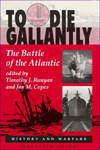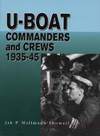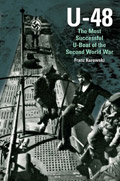To Die Gallantly: The Battle of the Atlantic
Runyan, Timothy J. and Copes, Jan M. (editors)
1994, Westview Press
ISBN 0813323320
Paperback, 347 pages, 23 b&w photos, 4 maps, 6 charts, 8 tables
| Type. | Collection of Papers |
| Pros. | Some little-studied topics investigated |
| Cons. | Some poor editing; paper on movies was disappointing |
| Rating. |  |
 The title of this book comes from Raeder's response to Hitler's demand in 1939 that the Kriegsmarine prepare for war against the Allies; Raeder replied that the only thing the Kriegsmarine would be able to do would be to show the world how to die gallantly.
The title of this book comes from Raeder's response to Hitler's demand in 1939 that the Kriegsmarine prepare for war against the Allies; Raeder replied that the only thing the Kriegsmarine would be able to do would be to show the world how to die gallantly.
This is a collection of 20 scholarly papers by different authors on various aspects of the Battle of the Atlantic. A lot of ground is covered here, including some topics not often investigated, among their number a comparison of the views of Stimson and Knox on strategy and planning for the Battle of the Atlantic, and two papers focusing on Brazil.
One of the more interesting papers is Milner's "Squaring the Corners: The Royal Canadian Navy and the Pattern of the Atlantic War," which illustrates the Canadian Navy's most significant contributions to the Battle of the Atlantic. Milner argues that the slowness of the United States to implement a coastal convoy system was a result of seeing firsthand the rather unimpressive results of transport in the slow Canadian-escorted convoys. He takes issue with Gannon's (Operation Drumbeat) assessment of Canada's inability to aid in the defense of US coast, pointing out that Canadian forces were at low capacity precisely because they were being so heavily utilized in the Atlantic. After close analysis of the Canadian track record and reasons for their failures, Milner concludes that the Canadians actually contributed rather more to the campaign than commonly recognized.
Several other papers are worth noting. A contribution by James Cheatham (author of Atlantic Turkey Shoot), "U-boat War off the Outer Banks", is a colloquially told but very interesting account of Carolina residents' direct experiences of the U-boat war. One of the book's flaws is a rather large number of typographical and spelling errors, and this chapter is no exception, repeatedly spelling Hardegen as Hardigan. A paper by David Syrett (author of Defeat of the German U-boats) closely examines the courses of three February 1943 convoys - ONS 165, ON 166, and ONS 167. Philip Lundeberg's "Operation Teardrop Revisited" gives an interesting insight into the final months of the war at sea, as well as the brutal interrogation of Paul Just of U-546 in late April 1945. "Kapitaen Fred Krage: Blockade Runner" is another interesting paper, as are one analyzing merchant marine losses, and another on the port of New York during the war.
The last paper in the book, on movies, was rather unsatisfactory, however. The author completely misses the mark in his evaluation of Das Boot, and does not deal very accurately with The Enemy Below either. Unfortunately the reader's impression is that, while the author may be an expert on feature films, he has little knowledge of U-boats or the Battle of the Atlantic, and made value judgments based on his own opinions rather than approaching his subject objectively through research. However, although this particular paper was a disappointment, the majority of the others were quite useful and informative, shedding light on some under-studied corners of the campaign.
Review written by Tonya Allen.
Published on 21 May 2000.
Purchase information: (info) Get To Die Gallantly: The Battle of the Atlantic now at amazon.co.uk
Get To Die Gallantly: The Battle of the Atlantic now at amazon.co.uk
Return to our main review page.



